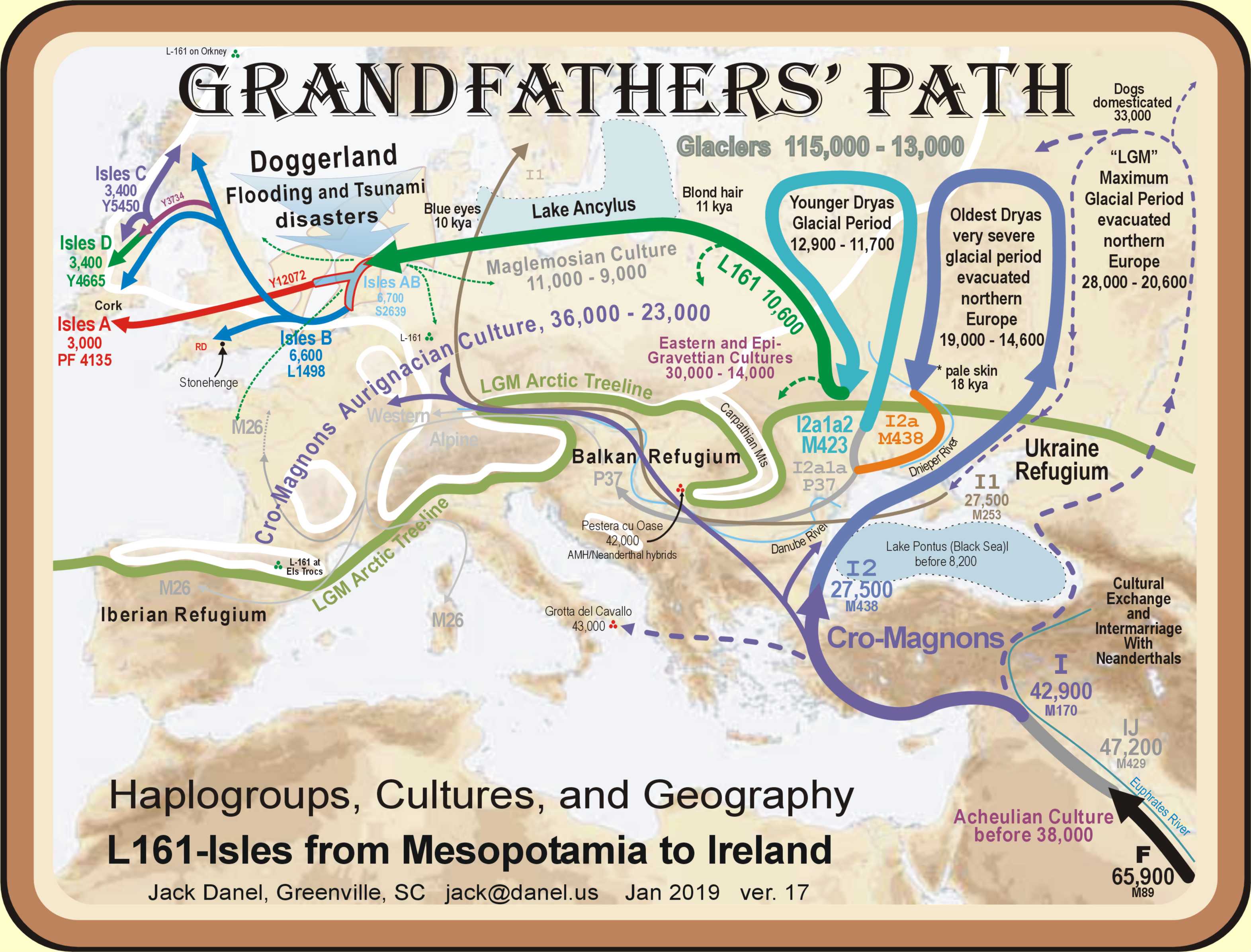




Haplogroup L161
13,400 y.a. ___SNP Y3104*, a descendant of M423 was formed.
000000 y.a. __ End of the Pleistocene
000000 y.a. __ Start of the Boreal Climate period
11,660 y.a. __End of the Paleolithic
00000 y.a. __ Beginning of the Mesolithic
11,000 y.a. __The hair color gene MC1R causing blond hair developed in northern Europe.
10,600 y.a. ___Haplogroup I2a1a2a now known as L-161 branched off from M423.
9,000 y.a. __Post-glacial re-population of Ireland began in Cork across a landbridge
In the Irish legends about the arrival of various groups in Ireland, there were always people present before the immigrants arrived - similar to the 'discovery' of America when natives were already there when the immigrants arrived.
In Ireland those 'natives' would be the Fomorians of legend. They were subgroups of Haplogroup I2a who had come north from the Iberian refugium crossing the short-lived land bridge to Ireland about 10,500 years ago.
The location was probably northwest of Lake Pontus (the Black Sea in a freshwater phase). There were five major river deltas in that area, so the environment for hunter-gatherers was ideal. The founding was in the Allerod warm climate phase, so the geographic possibilities for the location are numerous. (* SNP Y3104 defines this group, but recent posting by the ISOGG shows Y3104 as a branch away from our line.)12,900 y.a. ___The Younger Dryas little ice age begins abruptly.
There is evidence that it was perhaps caused by a collision with a comet, and perhaps compounded by one of the drainages of Lake Agassiz. The sharp cold lasted 1,300 years, but was not as severe as the Oldest Dryas. Some small groups were able to 'winter through' and survive in small villages as far north as Hamburg Germany. Most, however, were driven back into the refugia. The 'Grandfathers Path' graphic shows L-161 as being north of the edge of the Ukraine refugium after the Younger Dryas.11,660 y.a. __ End of the Younger Dryas

Grandfathers Path
000000 y.a. __ End of the Pleistocene
000000 y.a. __ Start of the Boreal Climate period
11,660 y.a. __End of the Paleolithic
00000 y.a. __ Beginning of the Mesolithic
The difference between the paleolithic and the mesolithic is based on their technology and lifestyle. Paleolithic peoples used crude stone tools made by chipping and lived nomadically in crude shelters and caves. In the mesolithic, better stone tools were shaped and polished by grinding, pottery was coming into use, and some permanent housing structures were built.11,500 y.a. __As the glaciers retreated, M423 migrated northward from the Ukraine Refugium.
The rivers leading northward from Ukraine allowed these migrants to reach the shores of a freshwater lake called Lake Ancylus (the Baltic Sea in a freshwater phase).11,000 y.a. __The Maglemosian culture was established around Lake Ancylus and in Doggerland.
11,000 y.a. __The hair color gene MC1R causing blond hair developed in northern Europe.
10,600 y.a. ___Haplogroup I2a1a2a now known as L-161 branched off from M423.
L161 was founded somewhere between Ukraine and Doggerland, but it is not at all clear where that happened. The warm climate would have allowed hunter/gatherers to travel far to the north and westward along the shore and into Doggerland, a huge marshland three times the size of Ireland where the mesolithic lifestyle was relatively easy.10,000 y.a. __A genetic mutation in one woman caused blue eyes in some of her descendants.
(SNP L-161.1 defines this group)
9,000 y.a. __Post-glacial re-population of Ireland began in Cork across a landbridge
Several subgroups of Haplogroup I2a coming north from the Iberian refugium would have been the pioneers to cross the landbridge as the ice retreated.
In the Irish legends about the arrival of various groups in Ireland, there were always people present before the immigrants arrived - similar to the 'discovery' of America when natives were already there when the immigrants arrived.
In Ireland those 'natives' would be the Fomorians of legend. They were subgroups of Haplogroup I2a who had come north from the Iberian refugium crossing the short-lived land bridge to Ireland about 10,500 years ago.